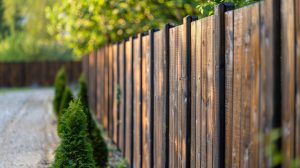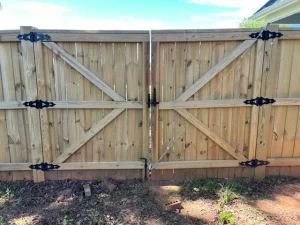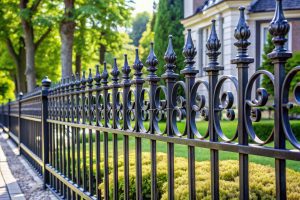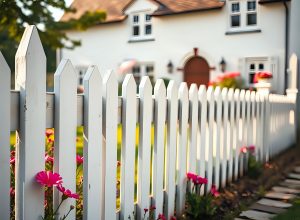Wood is a popular fence material due to its curb appeal, abundance, and relative ease of installation. But what type of wood is best? That depends on rot resistance, durability, budget and other concerns.
Cedar is one of the most common wooden fence materials because it checks a lot of those boxes. In this blog, we’ll address common questions to help you decide if a cedar fence is right for you.
Is Cedar Good for Fencing?
One of the first questions we get is also the most obvious: does cedar make a good fence? In short, yes. When it comes to wooden fencing materials, cedar is an excellent choice due to several reasons:
- The aromatic scent of cedar is due to compounds called “thujaplicins” that naturally repel insects
- Thujaplicins also act as preservatives, making cedar resistant to rot
- Cedar does not warp or sag
- It’s also humidity-resistant
- Cedar doesn’t shrink or swell even during extreme weather changes
- It’s a naturally beautiful wood that adds warmth to any design
- Cedar can be stained to complement different aesthetic styles
How Long Does a Cedar Fence Last?
The lifespan of a cedar fence depends on a number of factors.
The climate where you live can impact your fence’s longevity. While cedar is weather-resistant, constant exposure to harsh UV rays can fade and dry out the wood. However, you can block damaging ultraviolet light by applying an opaque stain.
Additionally, cedar fences will last longer if you apply a waterproof sealer. This process should be repeated every three to five years.
Cleaning your fence once a year will also help it last longer. A combination of warm water, dish soap and bleach will remove any mildew stains. Not only does this make your fence look better, but it also protects it from wood rot.
When properly taken care of, a cedar fence can last up to 40 years. Even without routine maintenance, they may stand as long as 15-25 years.
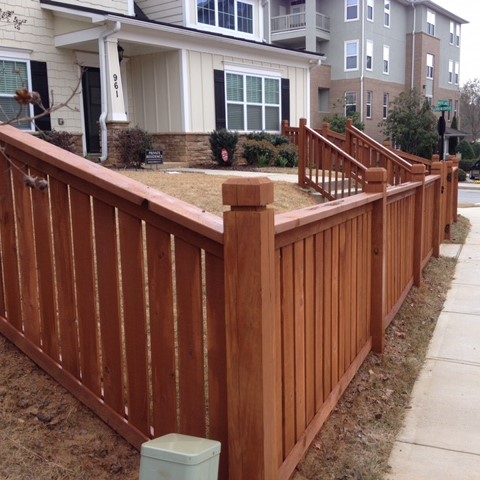

Fence Maintenance: Cedar vs Pressure Treated Pine
If you’re wondering if cedar requires more maintenance than other popular wood types, the answer is usually no. Pressure-treated wood fences require regular maintenance to look their best. This includes annual inspections for signs of damage or rot, bi-annual cleaning, and resealing or repainting every three to five years.
Additionally, pine is more likely to sag, warp, or split than cedar. When that happens, the affected boards should be replaced. Even with routine maintenance, most pressure-treated pine fences have a lifespan of just ten to fifteen years.
What Are the Best Cedar Fence Stain Colors?
While cedar is beautiful on its own, a high-quality stain will bring out the natural warmth and help preserve the wood. Semi-transparent stains offer a hint of color, allowing the wood to show through. On the other hand, opaque or solid stains more closely resemble paint in appearance while penetrating the wood.
Many stains offer UV and mildew protection as well. Exterior oil or acrylic/oil blends are the best stain choices for cedar and two coats should be applied every five to seven years.
But what’s the best color? Stain color choices are an individual decision that should reflect your overall design aesthetic. However, “natural” tones tend to work well with cedar, enhancing rather than obscuring its inherent warmth and rustic charm.
Cedar-tone, walnut, pecan, redwood, and chestnut stains all honor their namesake woods. Any of these shades work well with cedar. Additionally, grey tones mimic cedar’s natural weathering process.
Are There Quality Differences in Cedar Fence Pickets?
The most common type of cedar used in fencing is Western Red Cedar, and it comes in two grades.
Wood is graded for the number of defects or “clearness” after manufacturing. Clear cedar comes from the heart of the tree and has almost no knots or blemishes. However, it’s too costly to use in most fencing projects.
#1 cedar comes from near the heart and has a low number of small knots. These knots aren’t likely to fall out, leaving a hole in your fence. On the other hand, #2 cedar has multiple knots, both small and large. It also has more color variations than #1 cedar.
Both grades of cedar are structurally sound, but #1 will have a smoother, less blemished appearance. Keep in mind that it also comes at a higher price point.
Can You Build a Cedar Split Rail Fence?
Split rail fences are one of the oldest and most enduring wooden fence types. Because their design requires an easy to split, rot resistant wood, most were made from American chestnut trees. However, a blight wiped out over three billion of these trees during the first half of the twentieth century.
As a result, people began looking for other wood options. Yellow pressure-treated pine became a popular choice in the eastern U.S. due to its abundance. But if you ask most fence installers today, they will tell you that cedar is a better choice. Cedar is weather and water resistant, repels insects, lasts for decades and ages to a beautiful grey. If you’re thinking about installing a split rail fence, then yes, cedar is an excellent option.
More Cedar Fence Questions? Ask the Experts
If you have questions about cedar fencing, or any other fencing materials, the experts at First Fence of Georgia are here to help. Contact us or give us a call at 770-422-9996.

